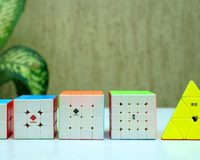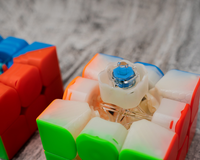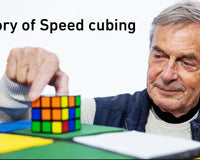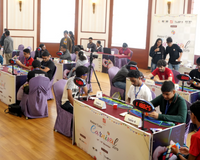Introduction
Solving a Rubik’s Cube blindfolded is an impressive trick that requires not only a good understanding of the cube but also knowledge of memorization techniques and execution. For beginner cubers, solving the cube blindfolded may seem scary, but with the right strategies, it’s easily achievable!
Understanding the Basics of Blindfold Solving
Blindfolded solving, commonly referred to as “BLD” in the cubing community, involves memorizing the cube’s scrambled state, putting on a blindfold, and then solving the cube purely from memory. The process is split into two key phases:
- Memorization – Learning and recalling the cube’s scrambled state.
- Execution – Applying algorithms while blindfolded to return the cube to its solved state. For beginners, a popular approach is the Old Pochmann Method for edges and corners. This method is simple and easy to learn, making it ideal for someone new to blindfolded solving.
Memorization Techniques

The memorization phase is arguably the most critical part of blindfolded solving. You need to remember the locations of each piece of the cube and where they need to go.
1. Letter Pairing for Piece Positions
For a beginner, the first step is assigning letters to each position on the cube. Each sticker on the cube’s edges and corners is given a unique letter. You’ll eventually be able to recall that, for instance, the sticker on the top-left corner in the top face of the cube is "A”, while the one on the top-right corner of the front face is “J”.

By doing this, you can form letter pairs that represent the cube's scrambled state. For example, if you memorize that "AXJY" means the sticker on position A needs to go to position X, and the sticker on position X needs to go to position J, and so on. You can build sequences of letters that represent your scramble.
2. Visual and Auditory Memorization
There are two main types of memorization styles: visual and auditory. Visual memorizers "see" where the pieces are in their mind's eye, while auditory memorizers use sounds, words, or even stories to memorize. Beginners may find it easier to use a combination of both.
For edges, you can create a sentence or a story with your letter pairs. For instance, if your letter pairs are "AX," "BY," and "CZ," you can create a silly sentence like “Axe the boy with a cozy zebra.” The more bizarre the sentence, the easier it will be to recall while solving.

Corners are memorized separately but use a similar letter pairing process. Once you become proficient at this, you'll be able to memorize a scrambled cube in under a minute.
Executing the Solve Blindfolded

Once you’ve memorized the cube, it's time to execute the solve while blindfolded. For beginners, the Old Pochmann Method is a simple and effective way to execute both edges and corners.
1. Solving Edges Using Old Pochmann
In the Old Pochmann method, one edge is treated as the “buffer,” where pieces will be cycled to the correct position. The method uses a fixed algorithm to swap the buffer with another edge. Your job is to recall your letter pairs and apply the algorithm to move each piece into its correct position, all while keeping track of which pieces you've already solved.
2. Solving Corners Using Old Pochmann
The process for solving corners is similar to edges but with a different set of algorithms. Again, you’ll have a “buffer” corner that is cycled with others to their correct spots. The execution phase for corners follows a similar process: you set up the pieces and apply the appropriate algorithm based on your letter pairs until all the corners are solved.
The key here is to focus on one piece at a time. Beginners often make the mistake of trying to solve too quickly, which can lead to errors. Take your time, especially when you’re starting out.
Tips for Beginners

- 1. Start with Slow and Careful Memorization: When first learning blindfolded solving, take as much time as you need with memorization. Don’t worry about speed yet. Focus on accuracy. Speed will come with practice.
- 2. Practice Execution Without Blindfold: Before jumping into blindfolded solving, practice executing algorithms with your eyes open. This will help you become familiar with the method’s patterns and develop muscle memory.
- 3. Break Down the Memorization Process: Memorizing the entire cube can be overwhelming at first. Try memorizing just the edges first, solving them, and then moving on to the corners. This way, you can ease into the full blindfolded solve gradually.
- 4. Use a Blindfold Only After Gaining Confidence: Initially, try "pseudo" blindfold solves where you keep your eyes closed but remove the blindfold if you get stuck. This way, you can verify your progress and correct mistakes early on.
- 5. Embrace Mistakes as Part of Learning: Don’t be discouraged if you mess up, especially when you’re first starting. Blindfolded solving is a highly advanced skill, and every mistake helps you learn more about how the cube behaves.
- 6. Engage in the Cubing Community: The cubing community is full of helpful resources and supportive cubers who can provide advice. Whether through YouTube tutorials, forums, or social media groups, connecting with other blindfold solvers will boost your learning process.
Conclusion
Solving the Rubik’s Cube blindfolded is a tricky skill, but using the above tips and tricks, you can get better at blindfolded solving in no time. Good luck impressing your friends and relatives with this new skill!
Happy cubing!






























